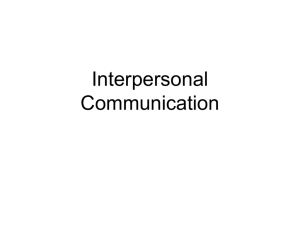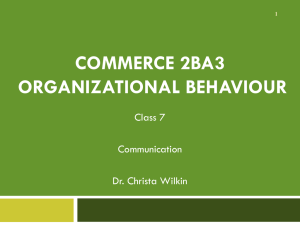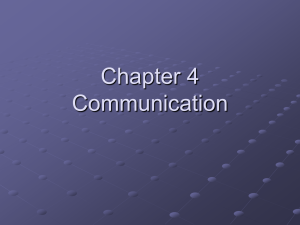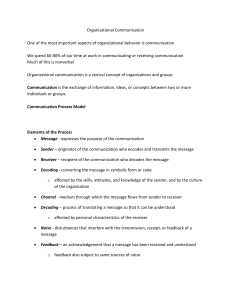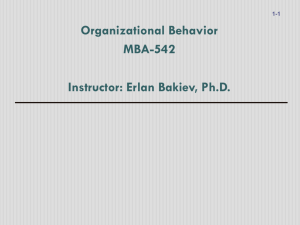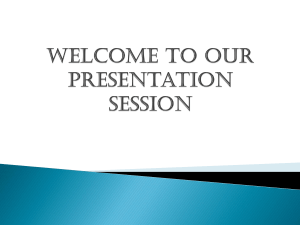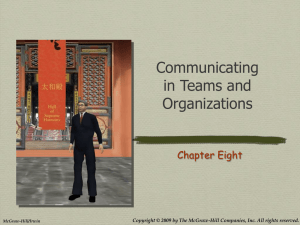Management 9e
advertisement
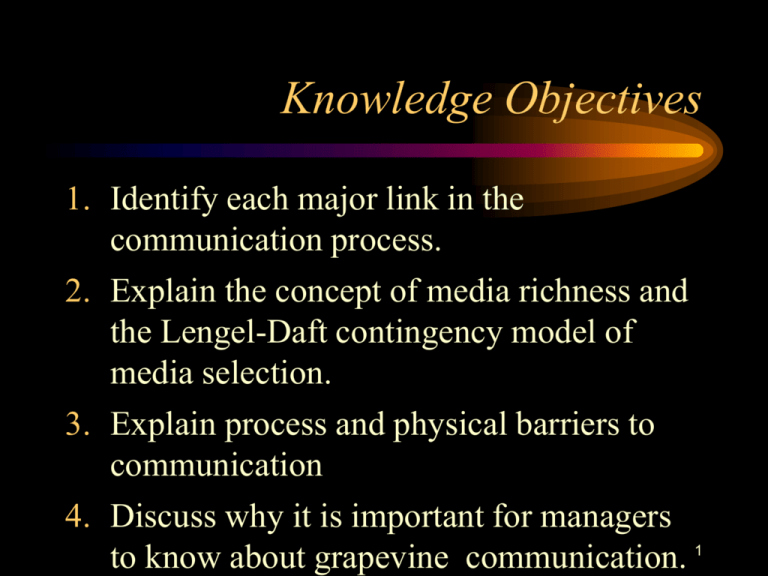
Knowledge Objectives 1. Identify each major link in the communication process. 2. Explain the concept of media richness and the Lengel-Daft contingency model of media selection. 3. Explain process and physical barriers to communication 4. Discuss why it is important for managers to know about grapevine communication. 1 The Communication Process • Communication – The interpersonal transfer of information and understanding from one person to another. • A linked social process of sender, encoding, medium, decoding, receiver, and feedback. 2 The Communication Process Sender 2 Encoding Start 1 Meaning Noise 3 Transmission through channels 8 Decoding 7 Transmission through channels (Receiver) Noise Receiver 4 Decoding 5 Meaning 6 Encoding (Sender) Numbers are sequential steps 3 The Communication Process (cont’d) • Encoding – Translating internal thought patterns into a language or code the intended receiver of the message will likely understand and/or pay attention to. • Choice of words, gestures, or other symbols for encoding depends on the nature of the message. – Technical or nontechnical – Emotional or factual – Visual or auditory • Cultural diversity can create encoding challenges. 4 The Communication Process (cont’d) • Noise – Noise: any interference with the normal flow of communication. – Understanding decreases as noise increases. – Dealing with noise • Make messages more understandable. • Minimize and neutralize sources of interference. 5 The Communication Process (cont’d) • Decoding – Successful decoding depends on the receiver having • a willingness to receive the message • ability to overcome perceptual “screening in” and “screening out”). • knowledge of the language and terminology used in the message. • an understanding of the sender’s purpose and background situation. 6 The Communication Process (cont’d) • Feedback – The choice factors for the form to provide feedback are the same factors governing the encoding process. – Feedback affects the form and content of follow-up communication. – Effective feedback is timely, relevant, and personal. 7 The Communication Process (cont’d) • Selecting a Medium – Face-to-face conversations – Telephone calls – E-mails – Memorandums – Letters – Computer reports – Photographs • Bulletin boards • Meetings • Organizational publications • News releases • Press conferences • Advertising 8 The Communication Process (cont’d) • Selecting a Medium (cont’d) – Moving between low- and high-context cultures can create appropriate media selection problems. • In low-context cultures, the verbal content of the message is more important than the medium through which it is delivered. • In high-context cultures, the context (setting) in which the message is delivered is more important than the literal words of the message. 9 The Communication Process (cont’d) • A Contingency Approach (Lengel and Daft) – Media richness: a given medium’s capacity to convey information and promote learning. – Characteristics of rich mediums • Provide simultaneous multiple information cues. • Facilitate immediate feedback. • Have a personal focus. – Characteristics of lean mediums • Convey limited information (few cues). • Provide no immediate feedback. • Are impersonal. 10 Information Richness of Channels Information Channel RICH Information Richness Face-to-face discussion Highest Telephone conversations High Written letters/memos (individually addressed) Moderate Formal written documents (unaddressed bulletins or reports) Low Formal numeric documents (printouts, budget reports) Lowest LEAN Source: Adapted from Daft, Richard L., and Lengel, Robert H. “Information richness: A new approach to managerial behavior and organization design.” In Barry M. Staw and Larry L. Cummings (eds.), Research in Organizational Behavior, vol. 6. Greenwich, Conn.: JAI Press, 1984, 191–233. 11 Nonverbal Communication • Body Language – Nonverbal communication based on facial expressions, posture, and appearance. • Types of Body Language – Facial – Gestural – Postural • Receiving Nonverbal Communication – Awareness of nonverbal cues can give insight into deep-seated emotions. 12 Nonverbal Communication (cont’d) • Giving Nonverbal Feedback – Nonverbal feedback from authority figures significantly affects employee behavior. – Positive feedback builds good interpersonal relations – Sensitivity and cross-cultural training can reduce nonverbal errors when working with individuals from other cultures. 13 Dynamics of Organizational Communication (cont’d) • The Grapevine – The unofficial and informal communication system in an organization • Managerial Attitudes Toward the Grapevine – Managers have predominately negative feelings about the grapevine. – The grapevine is more prevalent at lower-levels of the managerial hierarchy. – The grapevine appears to be more influential in 14 larger organizations. Dynamics of Organizational Communication (cont’d) • Coping with the Grapevine – The grapevine cannot be extinguished. – Attempts to stifle the grapevine as likely to stimulate it instead. – Monitoring and officially correcting grapevine information is perhaps the best strategy for coping with the grapevine. 15 Upward Communication • Upward Communication – The process of encouraging employees to share their feelings and ideas with management. – Options for improving upward communication • • • • • • • Formal grievance procedures Employee attitude and opinion surveys Suggestion systems Open-door policy Informal meetings Internet chat rooms Exit interviews 16 Communication Problems and Promises in the Internet Age (cont’d) • Barriers to Communication (cont’d) – Semantic Barriers • Misinterpretation of the meaning of words and phrases by individuals. – Specialized occupational languages can create communication problems with outsiders. – Psychosocial Barriers • Differing backgrounds, perceptions, values, biases, needs, and expectations of individuals can block communications. 17 Communication Problems and Promises in the Internet Age (cont’d) • Barriers to Communication (cont’d) – Sexist and Racist Communication • Progressive and ethical managers are weeding sexist and racist language out of their vocabularies and correspondence to eliminate the demeaning of women and racial minorities. 18 Becoming a Better Communicator • Effective Listening – Tolerate silence; keep listening. – Ask stimulating, open-ended questions. – Encourage the speaker with attentive eye contact, alert posture, and verbal encouragers. – Paraphrase what you have just heard. – Show emotion to show your sympathy with speaker. – Know your biases and prejudices. – Avoid premature judgments. 19 – Summarize by reiterating what the speaker said. Communication Problems and Promises in the Internet Age • Barriers to Communication – Process barriers • • • • • • Sender barrier Encoding barrier Medium barrier Decoding barrier Receiver barrier Feedback barrier – Physical barriers • Devices and distance 20
